Calculating your solar water heater size correctly is essential for maximizing energy efficiency and cost savings. Proper sizing guarantees you meet your household's hot water demands while avoiding unnecessary expenses from oversizing. It optimizes system performance, considering factors like climate, location, and available roof space. You'll reduce reliance on conventional heating methods, potentially cutting annual water heating costs by 50-80%. Accurate calculations lead to a shorter payback period and extended system lifespan. By avoiding oversizing, you'll prevent wasted resources and decreased efficiency. Understanding the importance of correct sizing is just the beginning of your journey towards sustainable hot water solutions.
Energy Efficiency and Cost Savings
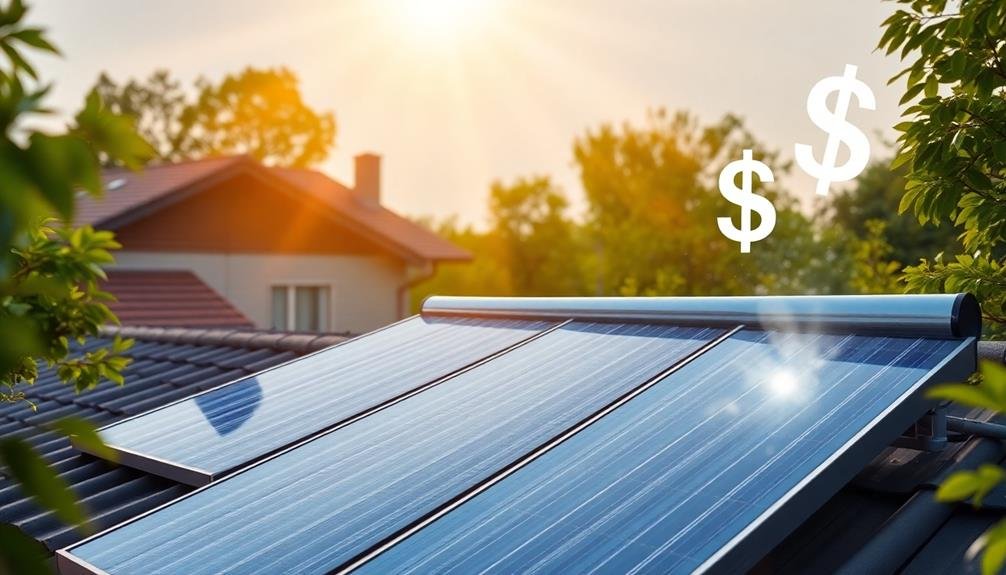
Three key benefits make solar water heaters an attractive option for homeowners: energy efficiency, cost savings, and environmental friendliness.
When you correctly size your solar water heater, you'll maximize these benefits. A properly sized system guarantees ideal energy efficiency by capturing and utilizing the maximum amount of solar energy available. This efficiency translates directly into cost savings on your utility bills.
You'll see a significant reduction in your reliance on conventional water heating methods, which can account for up to 18% of your home's energy use. By harnessing the sun's free energy, you'll cut your water heating costs by 50-80% annually. Over time, these savings will offset the initial investment in your solar water heater.
However, an incorrectly sized system can lead to inefficiencies and reduced cost savings. If it's too small, it won't meet your hot water needs, forcing you to rely on backup heating. If it's too large, you'll have wasted capacity and higher upfront costs.
Meeting Household Hot Water Demands
When determining the appropriate size for your solar water heater, it's crucial to accurately assess your household's hot water needs. Start by calculating your daily hot water consumption.
Consider the number of people in your home, their bathing habits, and other hot water uses like dishwashing and laundry. A typical person uses about 20-40 gallons of hot water per day, but this can vary.
Next, factor in peak usage times. You'll want your system to handle periods of high demand, such as mornings when multiple family members might shower consecutively.
Don't forget to account for seasonal variations; you may use more hot water in winter than in summer.
Consider your climate and available sunlight. If you live in an area with less sun exposure, you might need a larger system to compensate.
Also, think about future needs. If you're planning to expand your family or add water-intensive appliances, size your system accordingly.
Optimal System Performance
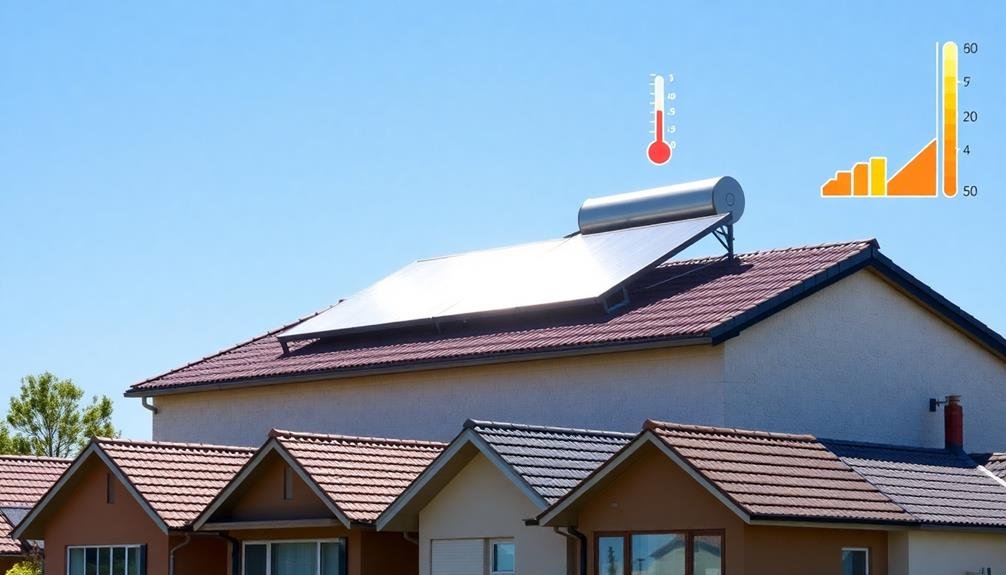
After determining the right size for your solar water heater, it's important to focus on maximizing its performance. You'll want to guarantee your system operates at peak efficiency to get the most out of your investment. Start by properly insulating your pipes and storage tank to minimize heat loss. Regularly clean your solar collectors to maintain their effectiveness, and check for any leaks or damage that could impact performance.
Consider installing a monitoring system to track your heater's output and efficiency. This'll help you identify any issues early on and make necessary adjustments. Don't forget to optimize the tilt angle of your collectors based on your location and the changing seasons. You should also implement a maintenance schedule to keep your system running smoothly.
| Aspect | Action | Benefit |
|---|---|---|
| Insulation | Properly insulate pipes and tank | Minimize heat loss |
| Cleaning | Regularly clean collectors | Maintain effectiveness |
| Monitoring | Install tracking system | Identify issues early |
| Positioning | Optimize collector tilt angle | Maximize sun exposure |
| Maintenance | Implement regular schedule | Guarantee smooth operation |
Preventing Oversizing and Wasted Resources
Oversizing your solar water heater can lead to unnecessary costs and wasted resources. When you install a system that's larger than necessary, you're not only spending more money upfront but also potentially decreasing the overall efficiency of your setup.
An oversized system may heat water beyond what you need, resulting in excess energy production that goes unused.
To prevent oversizing and optimize your solar water heater, consider these key factors:
- Your household's daily hot water consumption
- Local climate and average sunlight hours
- Available roof or ground space for collectors
- Budget constraints and long-term savings goals
By accurately calculating your solar water heater size, you'll avoid the pitfalls of an oversized system.
You'll reduce initial investment costs, minimize maintenance expenses, and guarantee that your system operates at peak efficiency.
Additionally, a properly sized system will have a shorter payback period, allowing you to recoup your investment more quickly.
Climate and Location Considerations

When sizing your solar water heater, you'll need to account for your specific climate and location.
You'll find that sunlight intensity varies greatly depending on your latitude and local weather patterns.
Additionally, you must consider seasonal temperature fluctuations, which can affect both the efficiency of your system and your hot water needs throughout the year.
Sunlight Intensity Variations
The intensity of sunlight plays an essential role in determining the size and efficiency of your solar water heater.
You'll need to take into account how sunlight intensity varies throughout the year in your location. Factors such as latitude, weather patterns, and seasonal changes all affect the amount of solar energy available to heat your water.
In areas closer to the equator, you'll experience more consistent sunlight year-round, allowing for smaller solar collectors.
However, if you're in a region with significant seasonal variations, you'll need to account for reduced sunlight during winter months. This may require larger collectors or supplementary heating systems.
To accurately calculate your solar water heater size, take into account these sunlight intensity factors:
- Peak sun hours in your location
- Seasonal variations in solar radiation
- Shading from nearby buildings or trees
- Local weather patterns, including cloud cover
Seasonal Temperature Fluctuations
Beyond sunlight intensity, seasonal temperature fluctuations greatly impact your solar water heater's performance and sizing requirements.
You'll need to take into account your location's climate patterns throughout the year to guarantee your system can meet your hot water needs in all seasons.
In colder months, your solar water heater will have to work harder to raise water temperatures, potentially requiring a larger system or additional backup heating.
Conversely, in warmer seasons, you might have excess capacity. To address this, you should size your system based on your winter requirements, as it's easier to dissipate excess heat in summer than to compensate for insufficient heating in winter.
Reflect on your region's temperature extremes and average seasonal variations.
If you live in an area with mild winters, you may need a smaller system compared to locations with harsh cold seasons.
Additionally, factor in the temperature of your incoming water supply, which can vary considerably between summer and winter.
This affects the energy required to heat water to your desired temperature.
Roof Space and Installation Requirements
Proper roof space and installation requirements are essential for an efficient solar water heater system. You'll need to assess your roof's available area, orientation, and structural integrity before installation. Generally, solar collectors require about 1-2 square meters of roof space per person in your household. Confirm your roof faces south (in the Northern Hemisphere) or north (in the Southern Hemisphere) for prime sun exposure.
Consider these key factors when evaluating your roof space and installation requirements:
- Roof angle: Ideally, it should be between 30-45 degrees for maximum efficiency.
- Shading: Avoid areas with obstructions like chimneys, trees, or nearby buildings.
- Weight-bearing capacity: Solar panels add extra load to your roof structure.
- Accessibility: Confirm there's enough space for maintenance and repairs.
You'll also need to plan for piping routes from the roof to your water tank and existing plumbing system.
If your roof isn't suitable, ground-mounted systems are an alternative. Always consult with a professional installer to determine the best location and setup for your solar water heater. They can help you navigate local building codes, permits, and potential structural modifications to confirm a safe and effective installation.
Longevity and Maintenance Planning
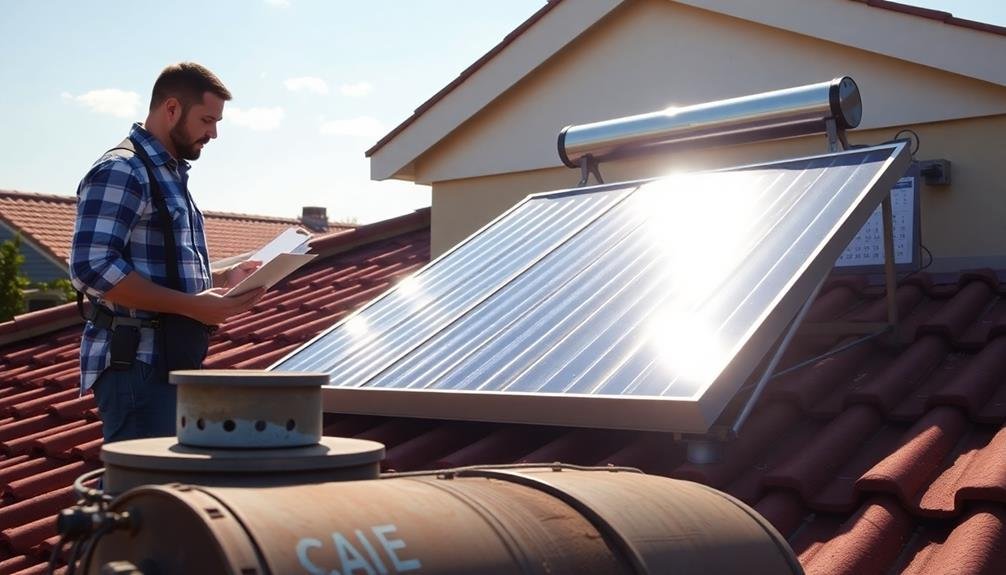
Investing in a solar water heater's longevity requires thoughtful maintenance planning. You'll want to take into account the system's lifespan and ongoing care to maximize your investment. Most solar water heaters last 15-20 years with proper upkeep, but neglect can greatly shorten this timeframe.
Regular maintenance tasks include checking for leaks, inspecting insulation, and cleaning collectors. You should also flush the system annually to remove sediment buildup. Don't forget to test the pressure relief valve and examine the heat transfer fluid every few years. By staying on top of these tasks, you'll guarantee ideal performance and extend your system's life.
| Maintenance Task | Frequency | Importance |
|---|---|---|
| Leak check | Monthly | High |
| Collector cleaning | Quarterly | Medium |
| System flush | Annually | High |
When planning for your solar water heater's longevity, factor in potential component replacements. Pumps and valves may need replacing after 10 years, while storage tanks might last the full system lifespan. By anticipating these needs, you'll avoid unexpected costs and maintain consistent hot water supply. Remember, proper sizing of your solar water heater also contributes to its longevity by preventing excessive wear and tear.
Frequently Asked Questions
Can a Solar Water Heater Work at Night or on Cloudy Days?
You'll find solar water heaters can work at night and on cloudy days, but with reduced efficiency. They store heat in insulated tanks, allowing you to use hot water even when there's no direct sunlight available.
How Long Does It Take to Install a Solar Water Heater?
You'll typically need 1-3 days for a solar water heater installation. It depends on your system's complexity, roof type, and weather conditions. Professional installers can often complete the job more quickly than DIY attempts.
Are Solar Water Heaters Compatible With Existing Plumbing Systems?
Yes, solar water heaters are typically compatible with your existing plumbing. You'll need to connect them to your current system, but they're designed to work alongside traditional water heaters. A professional installer can guarantee proper integration.
What Happens to Excess Hot Water Produced by Solar Water Heaters?
When your solar water heater produces excess hot water, you'll find it's typically stored in an insulated tank for later use. If there's still too much, it's often redirected to other applications or dissipated through a heat exchanger.
Can Solar Water Heaters Be Used for Radiant Floor Heating Systems?
Yes, you can use solar water heaters for radiant floor heating systems. They'll efficiently warm your floors by circulating heated water through pipes. You'll enjoy consistent, comfortable heat while saving energy and reducing your carbon footprint.
In Summary
You've learned why calculating solar water heater size correctly is essential. It's not just about efficiency and savings; it's about meeting your needs, optimizing performance, and avoiding waste. Remember to factor in your climate, available space, and long-term plans. By sizing your system right, you'll guarantee it works effectively for years to come. Take the time to do the math—it'll pay off in hot water and reduced energy bills.

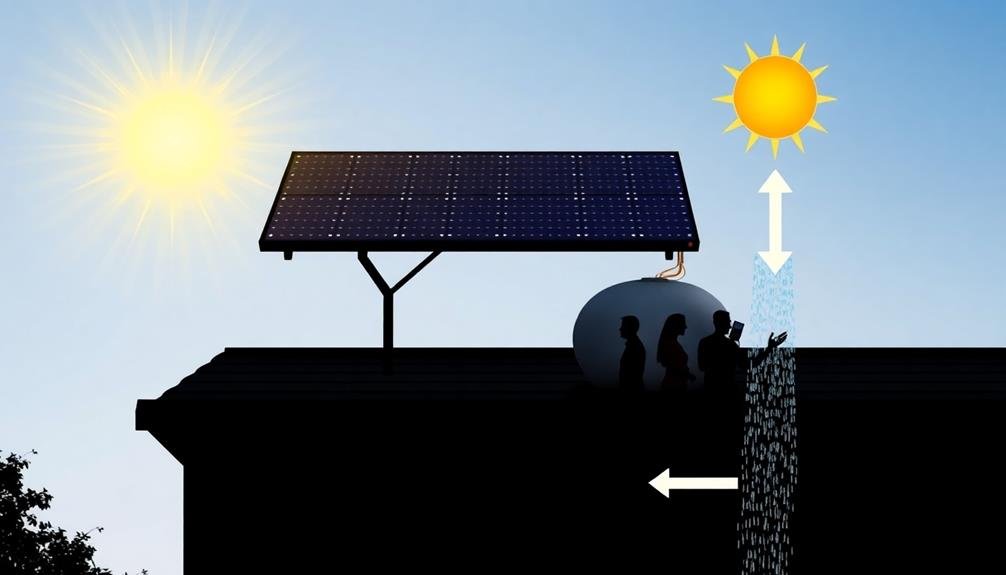
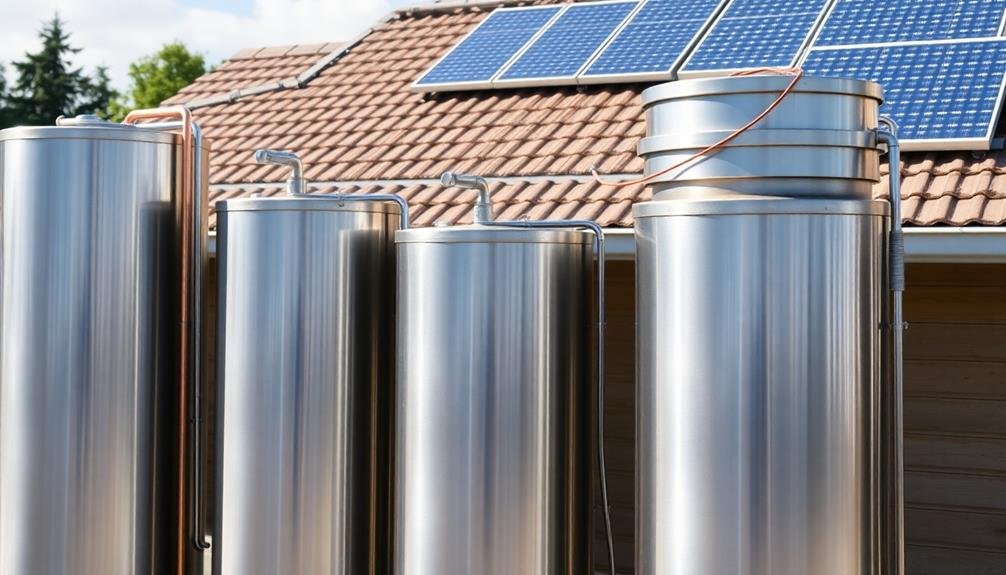
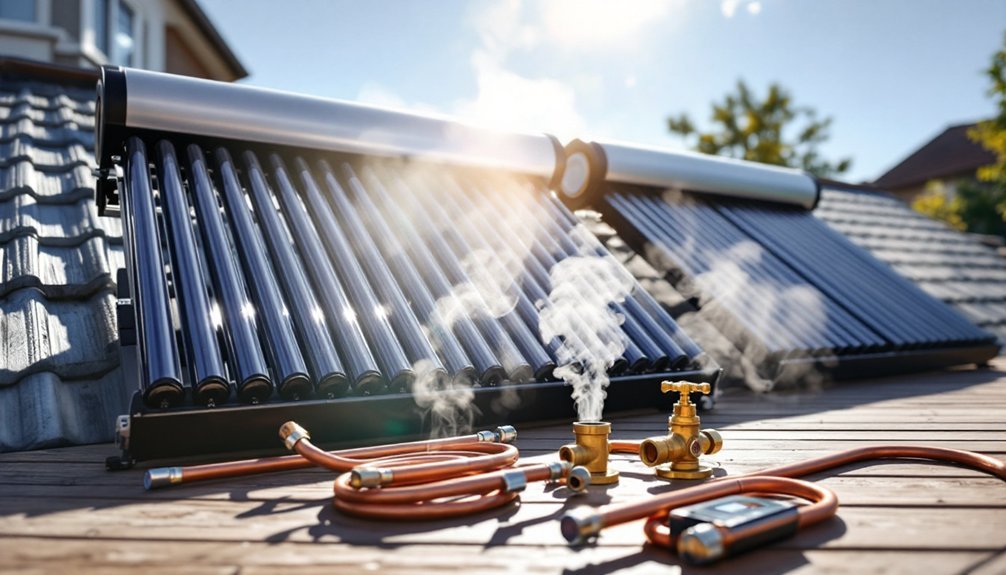
Leave a Reply